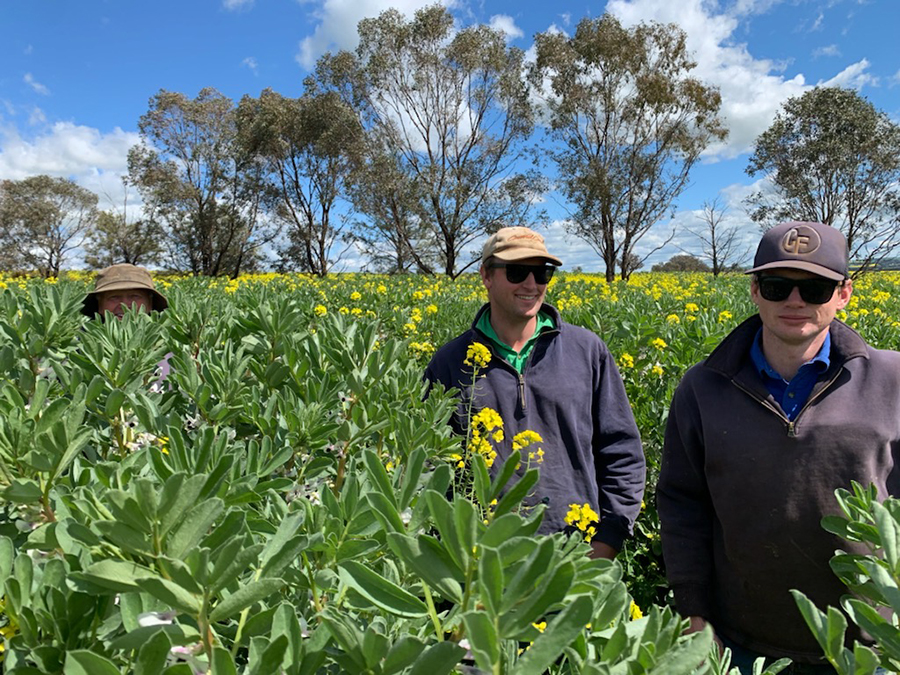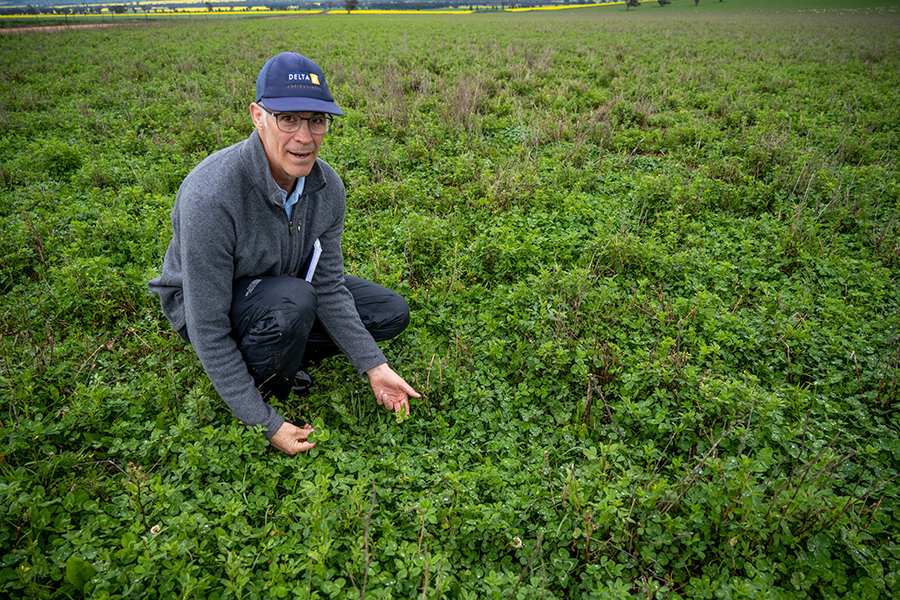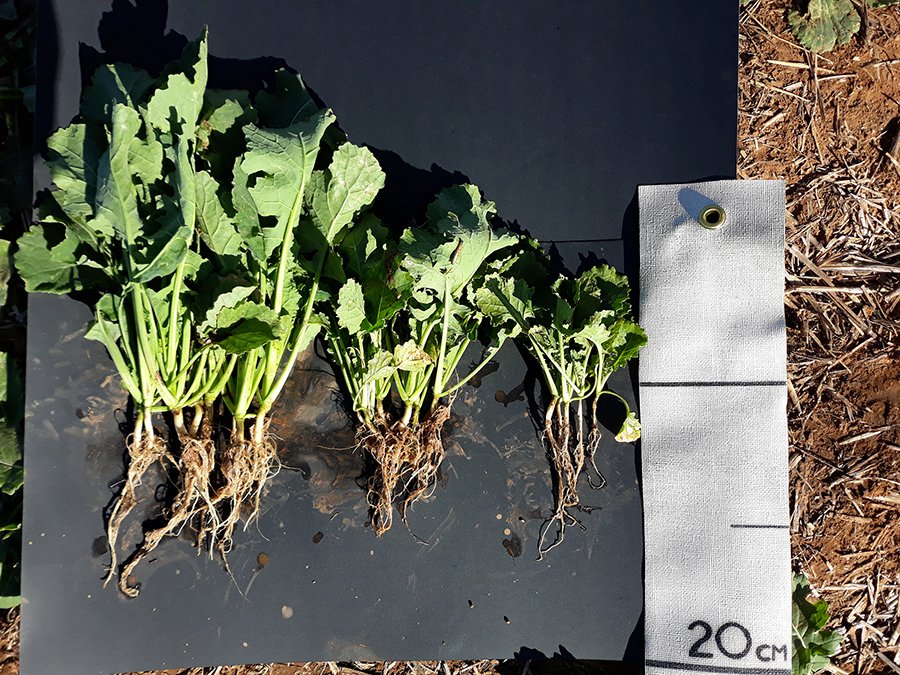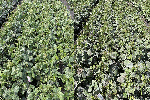Snapshot
Growers: Keith, Debra, Gregory and Andrew Lord
Location: Junee, NSW
Total farm area: 2200 hectares
Stock numbers: 3600 ewes
Average annual rainfall (long-term): 525 millimetres
Soil types: red to brown chromosols, duplex ranging from lighter sandy red loams to heavy red clay loam soils
Topography: Undulating
Soil pHCa targets: 5.6 (zero to 10 centimetres); 5.2 (10 to 20cm)
Enterprises: cropping and sheep
Crops: wheat, canola, barley, faba beans, pasture
When Keith Lord discovered subsurface soil acidity was constraining faba bean growth on his southern New South Wales farm, he realised it was the result of turning away from his long-term practice of incorporating lime and relying on sowing with a knife-point press wheel seeder to do the job.
Keith – who runs a 2200-hectare mixed farm near Junee with his wife Debra and sons Gregory and Andrew – now uses deep tillage to mix lime through acid subsurface soil 20 centimetres below the surface.
The shift came after the discovery by NSW Department of Primary Industries (DPI) development officer Helen Burns that moderate to severe subsurface acidity at depths of 20cm was causing the family’s faba beans to stunt and turn yellow.
“In 2016, while working on a GRDC investment investigating the constraints to legume production, I contacted Tim Condon at Delta Agribusiness to find out if he knew of any growers who were having problems with their legumes,” Ms Burns says.
“He pointed me to Keith’s faba bean crop, which had been planted into a paddock ameliorated five years earlier with a blanket application of 1.3 tonnes per hectare of lime. The faba beans had areas of good and poor growth.”
Initially, Ms Burns used a water-based soil pH test kit from a hardware store to gauge the acidity of the ‘good’ and ‘poor’ growth areas.
These results were confirmed with comprehensive soil testing in 2.5cm increments through the profile to 10cm and 5cm increments to 20cm.
In areas where faba bean plants were stunted and yellow (showing symptoms of nitrogen deficiency), soil test results and paddock observations confirmed the roots had hit an acidic layer with a pHCa of 4.1, five to 10cm from the surface (see Table 1).
Table 1: Soil pHCa results from six sites in five paddocks on the Lord family’s farm near Junee, NSW, in 2016-17.
Depth (cm) | Site name | |||||
A1 | A1 | Lucerne HV5 | HV9A | HV14 | HV18 | |
0 to 5 | 4.7 | 5.5 | 5.2 | 5.2 | 6.3 | 5.6 |
5 to 10 | 4.1 | 4.8 | 4.6 | 4.4 | 4.7 | 5.0 |
10 to 15 | 4.2 | 4.6 | 4.3 | 4.4 | 4.7 | 4.9 |
15 to 20 | 4.5 | 5.0 | 4.7 | 4.7 | 5.2 | 5.0 |
Notes: The soil pHCa results are from six sites in five paddocks across 300 hectares. Soil samples were collected from the dominant soil type. The results are a legacy of soil type and management history, including surface-applied lime application and incorporation with knife points and press wheels alone.
Source: Helen Burns, NSW Department of Primary Industries, 2022.
In the 10 to 15cm layer, soil pHCa ranged from 4.2 to 4.9. Ms Burns’ paddock observations showed faba bean root growth was concentrated in the top 4cm, with minimal growth below this.
Root disease was also evident and the faba beans were poorly nodulating, which likely constrained the amount of nitrogen fixed.
When GroundCover™ spoke to Keith in 2017, he felt both disappointment and relief. He was frustrated that his previous liming strategy was not effective but pleased to discover the cause of the poor faba bean growth so that his family’s lime incorporation tactics could be changed.
New targets
Based on the latest research – which reinforces the findings of long-term acid soil research undertaken at the NSW DPI ‘Managing Acid Soils Through Efficient Rotations’ site east of Wagga Wagga over 18 years – Charles Sturt University (CSU) soil scientist Dr Jason Condon and Ms Burns recommend targeting a soil pHCa of 5.8 in the soil layers that sit over an acid subsurface layer.
Incorporation using deep tillage fast-tracks the amelioration of subsurface acidity, ensuring alkali from the lime moves into deeper acid soil layers.
Now, Keith and his family, with the help of their farm consultant Tim Condon, are aiming for a soil pHCa of 5.6 in the top 10cm and 5.2 in the 10 to 20cm layer as a minimum.
After resurrecting an old scarifier fitted with sweep points and putting it to work in 2017 to incorporate lime in one paddock, Keith says he was not satisfied that the machine had moved lime to the depth needed to fix the acidity five to 15cm from the surface.
He asked a local dealer to demonstrate a four-metre Horsch Tiger MT. Keith and his team liked its capacity to mix subsurface soil to the depth required and level the seedbed in one pass.
To do this, the machine is fitted with heavy two-way scalloped discs. Behind the discs are tynes with points designed to loosen and mix the soil. A single row of levelling discs sits behind the tynes. Also fitted is a row of rubber tyre packers followed by steel rollers.
Compelling evidence
While the machine was a sizable investment, the family is convinced they needed to fix the acid subsurface soils after seeing Ms Burns’ soil pHCa results.
“We bought the Horsch Tiger MT in 2021 and a new John Deere tractor to pull it,” Keith says. “When they arrived on the same day in April, we put them to work immediately.”
While the machine has the capacity to mix soil up to 35cm deep, the family aims to work the soil to a depth of 20cm to ensure surface-applied lime reaches and reacts with the acid subsurface soil.
The family has observed the machine bringing up rich red clay, which is okay because their subsurface clay is not dispersive. Debra says an added benefit of the deep tillage is that it destroys mice burrows.
“We grew a companion crop of faba beans and canola in the first year after treating some of our paddocks with lime and deep tillage,” Keith says.
“The faba beans grew and nodulated brilliantly, and the canola also performed well. Since treating our soils with lime and deep tillage, we’ve noticed our crops have far more even growth.”

Keith, Gregory and Andrew Lord in a companion crop of faba beans and canola near Junee, NSW. The crop grew exceptionally well after lime was incorporated to a depth of 20 centimetres using a Horsch Tiger MT. Photo: Debra Lord
Tim Condon says soil amelioration with lime is critical for lifting a crop’s competitiveness against weeds. Dr Jason Condon agrees, adding that fixing acid soils also puts more options on the table for what can be grown.
“If you want to grow a legume to fix nitrogen organically or grow a broadleaf cover crop to control grass weeds, fixing your soil acidity will mean you don’t have to choose an acid-tolerant option,” Dr Condon says.
“Having crops with more-extensive root systems is also likely to offer more benefits to subsequent crops within the rotation.”
Another benefit, Ms Burns says, is that plants growing in healthy non-acid soil are less prone to disease.
“A lot of the root diseases we see, including Rhizoctonia, are secondary infections of stressed plants,” she says. “We’ve seen it in wheat, canola and clovers, with the unhealthy plants unable to combat disease pressure.”
Site-specific lime
The Lords employ Delta Agribusiness to aggregate data layers, including grain yields and soil types, to create paddock management zones.
Then, soil samples are collected within each management zone to a depth of 20cm in 10cm increments.
Although Ms Burns and Dr Condon recommend sampling in 5cm increments to a depth of 20cm to locate the acid soil layer, Mr Condon says his company’s soil sampling system does not allow this to be done efficiently over large hectares.
However, the baseline soil data provided by Ms Burns’ detailed sampling has given Mr Condon and the Lord family a good insight into the pH profiles they are dealing with.
As soon as lime is delivered and spread on the soil surface, the Lords put their deep tillage machine to work. To date, lime rates have varied from 1.5t/ha to 3.5t/ha, according to soil pHCa.
Since buying the Horsch Tiger MT, the Lords have mainly used it in paddocks earmarked for canola. But it has also been used to incorporate lime in paddocks earmarked for wheat undersown with pasture, and paddocks sown to faba beans.
Mr Condon says the family has aimed to incorporate as much lime as possible as quickly as possible.
“It doesn’t matter which paddocks are treated first because the Lords’ soil doesn’t have a large erosion risk,” he says.
“In landscapes with a higher erosion risk, incorporating lime when there is cereal stubble to hold the soil together would be important.”
Keith estimates that the family’s entire property should be treated in less than 10 years.
To date, more than half of the paddocks planted to canola in 2022 were treated. The remaining paddocks will be zoned and soil-sampled for treatment from 2023.
“In the next three to four years, we’ll have the bulk of the cropped country done,” Mr Condon says.
“But there are a bunch of pasture paddocks that won’t come back into cropping for another four to five years, and these will be treated then.”
Lime incorporation benefits
The Lords’ approach has already shown grain yield benefits. For example, in 2021, canola yields averaged 3.0 to 3.5t/ha in untreated paddocks. On treated paddocks, canola grain yields averaged 4t/ha.
Mr Condon says a research gap exists in this space because it is not known what caused the 0.5t/ha grain yield advantage.
“We think the number one benefit is incorporating lime using deep tillage and overcoming the toxic effects of soil acidity at depth,” he says. “But deep tillage is also likely to have redistributed phosphorus from the top 5cm to subsurface soil layers.”
Ms Burns says compaction removal with deep tillage is unlikely to have produced significant grain yield responses on the Lords’ farm in the past two wet seasons.
Nonetheless, Mr Condon says he has observed that the speed of crop development in paddocks treated with lime and deep tillage is nearly double that of paddocks yet to be treated.
“Where we ameliorated one paddock with lime and deep tillage before sowing it to wheat undersown with pasture, the wheat yielded 4t/ha, and the pasture is phenomenal,” he says.
“We also expected to dig up populations of black oats and radish using the deep tillage, but that didn’t happen.”
Care needed
In wet seasons, Keith says care needs to be taken when carrying out herbicide and fungicide treatments in treated paddocks.
“The soil is soft, and trafficability can be an issue after significant rainfall. We do not have all our wheel tracks matched, which would likely be useful for alleviating trafficability issues.”
While Keith has seen the value of strategic tillage to incorporate lime, he likes the idea of not using the machine again on paddocks for another 20 years, if at all.
Theoretically, Dr Condon says, if enough lime is applied and deeply incorporated to remove the ‘acid throttle’ at depth, maintaining the top 10cm above a pHCa of 5.5 with maintenance lime rates should allow the lime effect to move below 10cm over time.
“Monitoring and top-dressing lime to maintain pHCa above 5.5 should mean that, over time, you are less likely to see acid formation at depth,” he says.
“And theoretically, you shouldn’t have to incorporate lime to 20cm again. But we need long-term trials to prove this is the case.”
Mr Condon says the Lord family plans to apply lime and incorporate it as required at the start of the crop rotation and then top up the alkalinity with a simple top-dressing application without incorporation again at the start of the pasture phase. Soil test results will guide all lime rates.
“We know that growing three to 4t/ha of canola and 6t/ha of wheat will acidify the soil faster than in the past,” he says.
“But it is somewhat an unknown until more research results come to light.”
Ms Burns says the research she and Dr Condon are undertaking (through the FutureSOILS project and GRDC investment) aims to quantify the correct amount of lime to ameliorate acidic subsurface layers and the top-up rates and timings for different farming systems and soil types.
“Once you’ve neutralised a stratified acid soil by using deep tillage to kick-start the amelioration effect, we suspect lower top-up rates of lime will be required more frequently than previous recommendations,” she says. “However, more research is needed to fill the knowledge gaps.”
Risks considered
One concern of using deep tillage to incorporate lime at the front of Keith’s mind is the risk of drying out the soil in low-rainfall years.
“We are careful to pick the paddocks we treat so that our entire crop isn’t exposed to risk if conditions turn dry,” he says. “For the past two years, this hasn’t been an issue because we have had exceptionally wet conditions.”
Another consideration, Mr Condon says, is ensuring the deep tillage machine is well set up.
“I came across a hired Horsch Tiger MT machine last year that was not well set up. It left the paddock rough, and the crop planted into that paddock didn’t perform,” he says.
“The Lords’ machine is set up to ensure it leaves paddocks level. Other clients use offset discs which also leave paddocks level. It does depend on the operator and their experience.
“If we run into a series of droughts, we won’t use deep tillage to incorporate lime if we don’t have enough moisture to do the job.”
Keith says he prefers to wait until there is moisture in the soil before putting the machine to work to maximise penetration depth.
More research
Mr Condon says there are two knowledge gaps. “We would like to know if what we’ve done is fixing the acid band 5 to 15cm from the soil surface,” he says.
“Follow-up soil tests will be done in four years to check pHCa and determine when re-liming is necessary.
“To fine-tune how much lime is needed and when we need to re-lime, we look forward to seeing the results of Helen and Jason’s research.”
Collaboration benefits
Keith and his family have enjoyed collaborating with Ms Burns over the years: “Somebody once said, ‘when you have researchers digging around in your country, it’s a good thing’.”
Ms Burns says she is grateful to the Lords and other growers for trying faba beans and other acid-sensitive pulses, which detected the acidity issue.
In 2017, Keith called faba beans “the canary in the coal mine”, which allowed Ms Burns to discover the extent and severity of the pHCa stratification and subsurface acidity issue. It also allowed her to discover the cost to yield and profit of outdated and ineffective acid soil management advice.

Delta Agribusiness senior farm consultant Tim Condon in the paddock where NSW Department of Primary Industries development officer Helen Burns found the severely acidic subsurface layers. The paddock has had lime incorporated to depth, and pasture growth is now prolific and even. Photo: Nicole Baxter
“Uncovering the reasons for disappointing outcomes from ‘best management practice’ is fantastic for picking up the need to change management,” she says.
Back in 2015, Keith says normalised difference vegetation index (NDVI) imagery clearly showed poor production areas caused by acid subsurface soils.
Fast forward to now, and the latest NDVI imagery has demonstrated that these poor production areas have been fixed.
“Our pasture – comprising lucerne, chicory, white clover, arrowleaf clover, bladder clover and Persian clover – planted on the paddock, where Helen walked around assessing faba bean growth, is now growing exceptionally well because we fixed the acid subsurface soil,” Keith says.
More information: Keith Lord, homeview@westnet.com.au; Helen Burns, helen.burns@dpi.nsw.gov.au; Tim Condon, tcondon@deltaag.com.au; Jason Condon, jcondon@csu.edu.au

In FutureSOILS trials that include high-lime-rate plots near Burrumbuttock in southern NSW, Holbrook Landcare Network project officer Nick McGrath says molybdenum toxicity became evident as stunted and low-density canola plants. He says the canola plant on the left was grown in soil with a pHCa of 5.2 at a depth of zero to 10 centimetres. The canola plant in the middle was grown in soil with a pHCa above 5.5 at zero to 10cm. The plant on the right was grown in soil with pHCa above 5.5 at zero to 20cm. Photo: Nick McGrath
Watch out for molybdenum toxicity
Researchers in southern New South Wales have observed a link between lime application and molybdenum toxicity on soils where molybdenum has been applied in recent years.
Sodium molybdate is applied with pre-emergent herbicides as a source of molybdenum. It is commonly recommended for legumes and canola crops when soil pHCa is below 5.0.
Research has demonstrated that adding molybdenum can correct deficiencies in acid soils and improve plant growth and legume nodulation.
However, something to be aware of is that molybdenum availability increases in the soil as pH rises.
Charles Sturt University (CSU) soil scientist Dr Jason Condon, working with NSW Department of Primary Industries development officer Helen Burns, Holbrook Landcare Network project officer Nick McGrath and CSU honours student Grace Kaveney, have observed this phenomenon in paddock and glasshouse trials.
The FutureSOILS project trial site at Burrumbuttock, NSW, managed by Holbrook Landcare Network, and CSU glasshouse trials, show that liming increases molybdenum availability, sometimes to toxic levels.
Ms Burns says broadleaf plants such as canola and clover are more susceptible to high levels of molybdenum than cereals or grasses.
“If you’re applying lime to fix your acid soils and targeting a pHCa of 5.6 to 5.8, increased molybdenum availability means you don’t need to apply the molybdenum that you might have applied in the past,” Dr Condon says.
Ms Burns agrees, adding that the lime applied to the Burrumbuttock trial site in 2020 increased pHCa to well over 5.0 in the top five centimetres, leading to increased availability of molybdenum from the soil. This was in addition to the molybdenum applied in 2018, resulting in toxic levels of molybdenum.
“The germinating canola planted into lime-ameliorated soil suffered because the paddock had 120 grams per hectare of sodium molybdate applied in 2018,” she says. “What we don’t know is how long it will take for the molybdenum to drop below toxic levels in those treatments with high pH.”
Another issue to be aware of, Dr Condon says, is that there is a relationship between sulfate uptake and molybdenum.
“If a plant is taking up sulfate, it is less likely to suffer from molybdenum toxicity,” he says. “That’s probably why we have not seen molybdenum toxicity in canola because, generally, growers try to ensure they apply sulfur when growing a brassica.”
More information: Nick McGrath, nickmcgrath@holbrooklandcare.org.au

























































